Ross Sea Voyage
February 2023
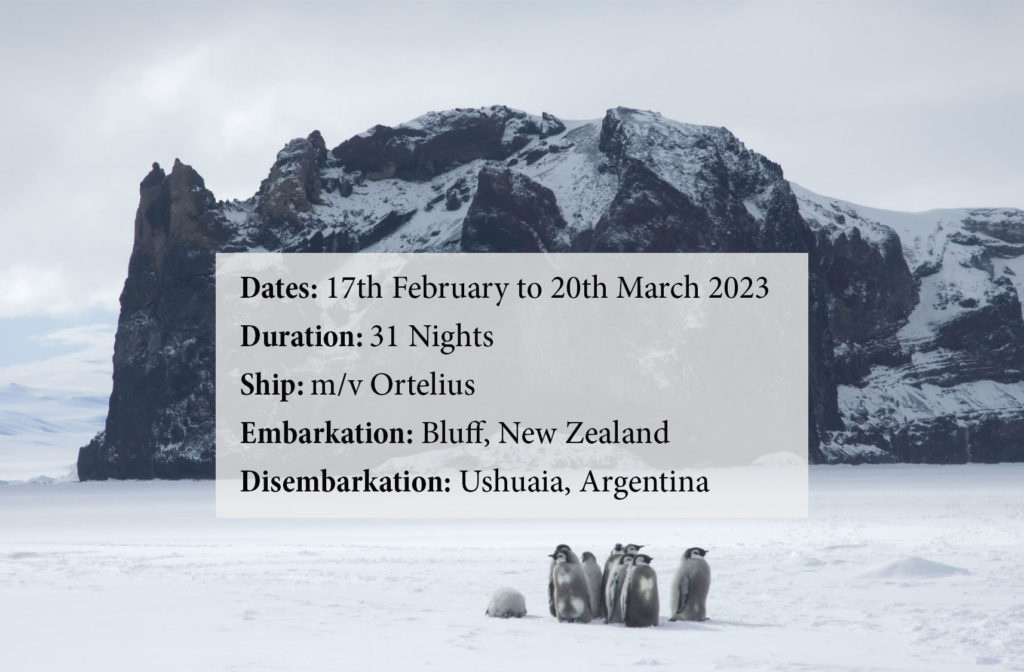
Day 1: New Zealand’s southernmost town
Your voyage begins in Bluff, commonly held to be New Zealand’s most southerly town. Sailing beyond the boundaries of the civilized world, you venture into the untamed regions of the far south.
Day 2: Sailing south with the seabirds
Seabirds trail your vessel across limitless horizons toward Campbell Island.
Day 3: Campbell Island’s bounteous birdlife
The plan today is to visit the sub-Antarctic New Zealand Reserve and UNESCO World Heritage Site of Campbell Island, enjoying its luxuriantly blooming vegetation. The fauna on Campbell Island is also a highlight, with a large and easily accessible colony of southern royal albatrosses on the main island. Breeding on the satellite islands are wandering, Campbell, grey-headed, black-browed, and light-mantled albatrosses. There are also three breeding penguin species present: eastern rockhopper, erect-crested, and yellow-eyed penguins. In the 18th century, seals in the area were hunted to extinction, but the elephant seals, fur seals, and sea lions have since recovered.
Day 4: Northwest by sea
You now sail northwest, again followed by numerous species of seabird.
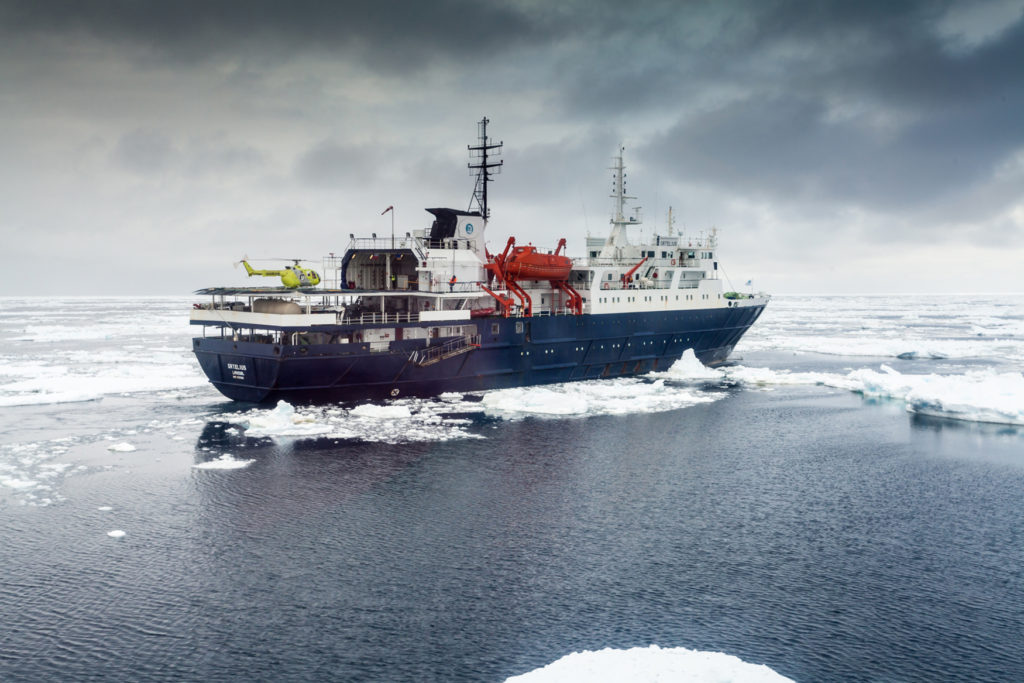
Day 5: Macca aka Macquarie Island
Macca, also known as Macquarie Island, is a Tasmanian State Reserve that in 1997 became a World Heritage Site. The Australian Antarctic Division has its permanent base on this island, which Australian sealer Frederick Hasselborough discovered while searching for new sealing grounds. The fauna on Macquarie is fantastic, and there are colonies of king, gentoo, and southern rockhopper penguins – as well as almost one million breeding pairs of the endemic royal penguin. Elephant seals and various fur seal species, such as the New Zealand fur seal, are also present.
Day 6 – 8: Once more to the Southern Ocean
You once again enter the vast expanse of the Southern Ocean. Sea birds are also prolific on this leg, during which we hope to enjoy good weather conditions.
Day 9: The windswept Balleny Islands
Your intended route is past Sturge Island in the afternoon, getting an impression of these windswept and remote islands before crossing the Antarctic Circle.
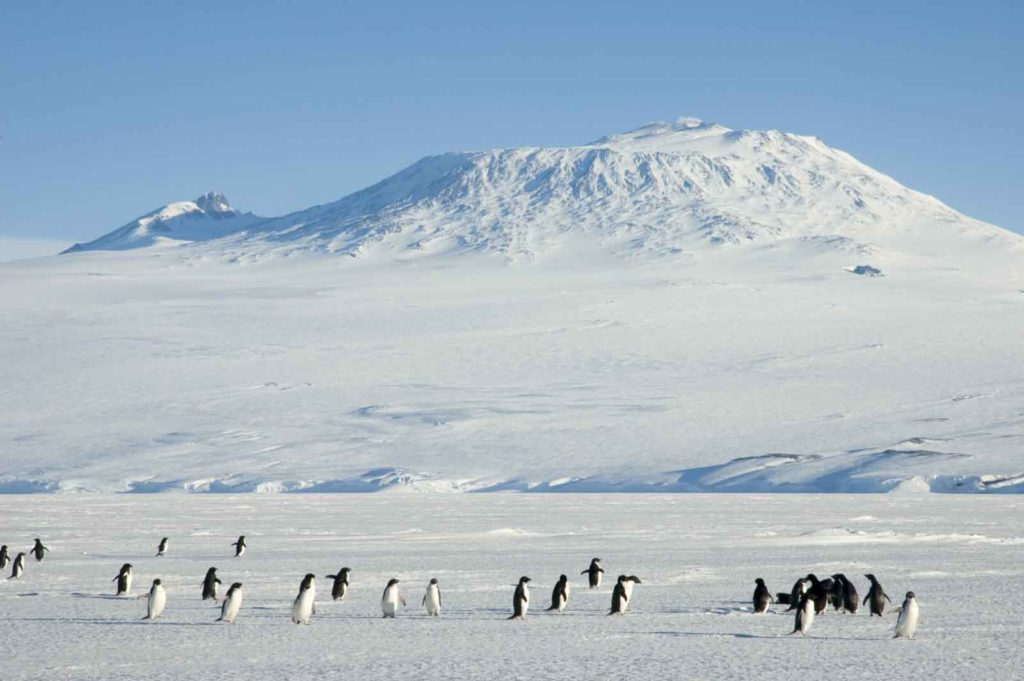
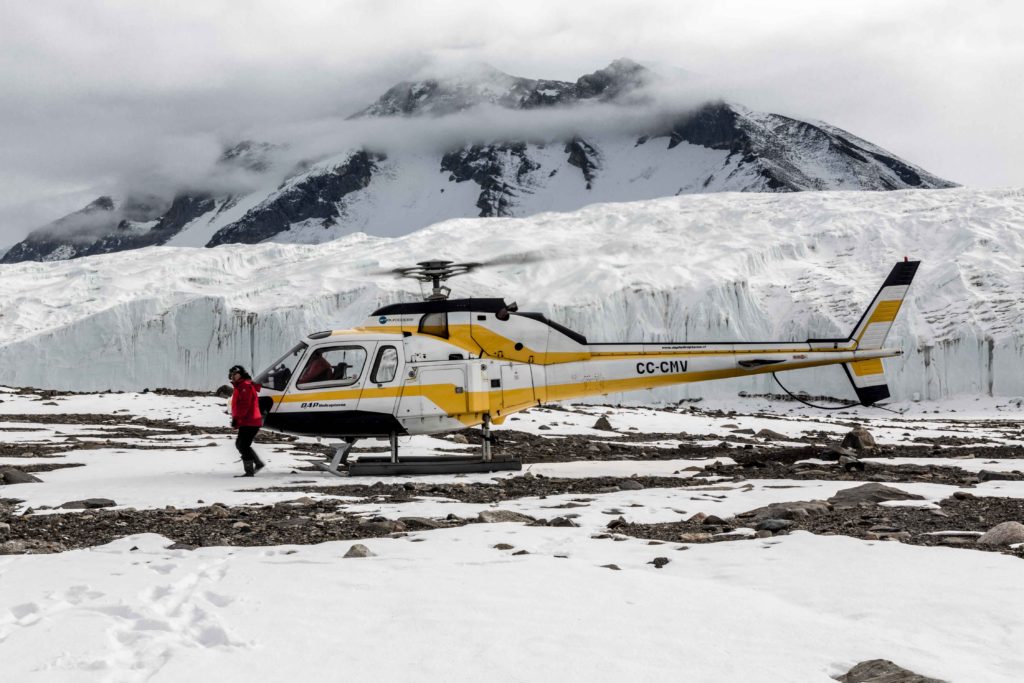
Day 10: Across the seas to the Antarctic Continent
By now you’ve become a veteran of the high seas, if you weren’t when you started the voyage. You spend today sailing toward the Antarctic Continent.
Day 11: The residents of Cape Adare
You next attempt a landing at Cape Adare, where for the first time humans wintered on the Antarctic Continent: The Norwegian Borchgrevink stayed in here 1899, taking shelter in a hut that to this day is surrounded by the largest colony of Adélie penguins in the world.
Day 12: Cape Hallett’s abundant Adélies
Sailing south along the west coast of the Ross Sea, you may attempt a landing at the protected area of Cape Hallett and its large Adélie penguin rookery.
Day 13: Exploring the inexpressible
If sea ice permits, you land at Inexpressible Island, which has a fascinating history in connection to the less-known Northern Party of Captain Scott’s expedition. It is also home to a sizable Adélie penguin rookery. You may also head farther south toward the impressive Drygalski Ice Tongue if ice conditions prevent entry into Terra Nova Bay.
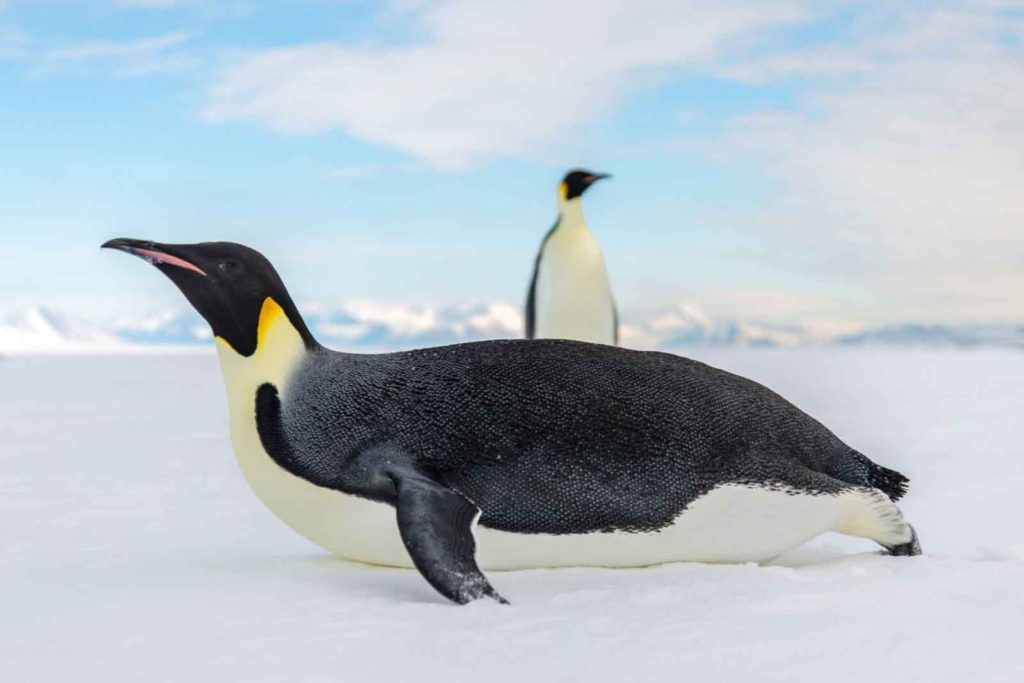
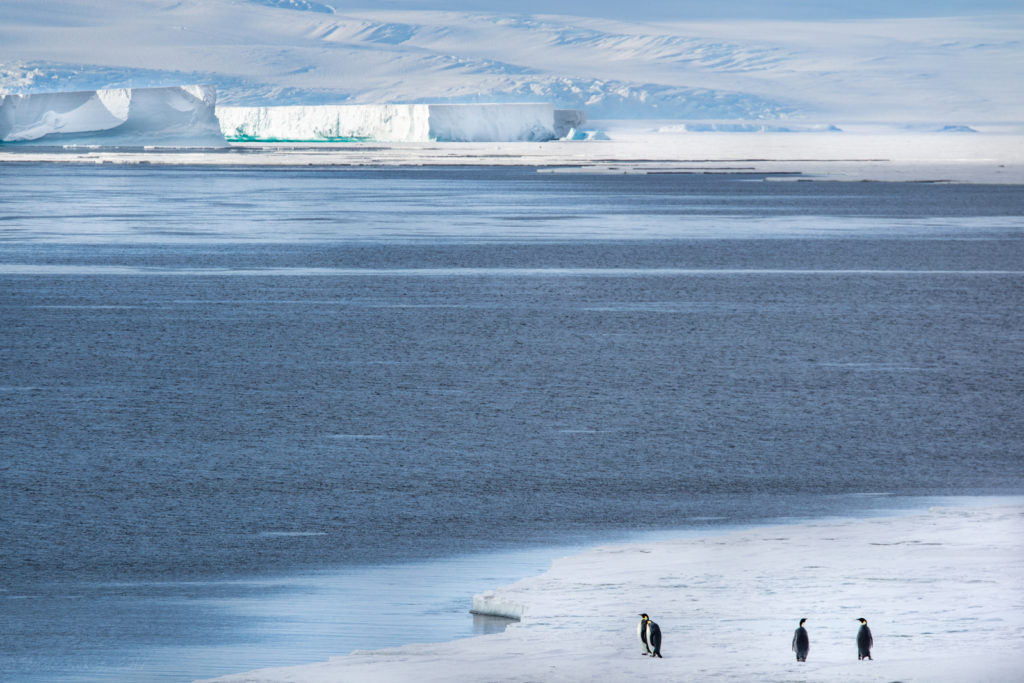
Keeping to the Ross Sea, your aim is now to visit Ross Island. In this location you can see Mount Erebus, Mount Terror, and Mount Byrd, as well as many other famous spots that played an important role in the British expeditions of the last century: Cape Royds, where Ernest Shackleton’s cabin still stands; Cape Evans, where the cabin of Robert Falcon Scott can still be seen; and Hut Point, from which Scott and his men set out for the South Pole.
If ice is blocking the way but weather conditions are favorable, you may use the helicopters to land in one or more spots in this area. The American scientific base of McMurdo Station and New Zealand’s Scott Base are other possible locations you might visit. From McMurdo Station you could also make a 10-km hike (6 miles) to Castle Rock, where there are great views across the Ross Ice Shelf toward the South Pole. Additionally, you may make a helicopter landing in Taylor Valley, one of the Dry Valleys, where conditions are closer to Mars than anywhere else on Earth.
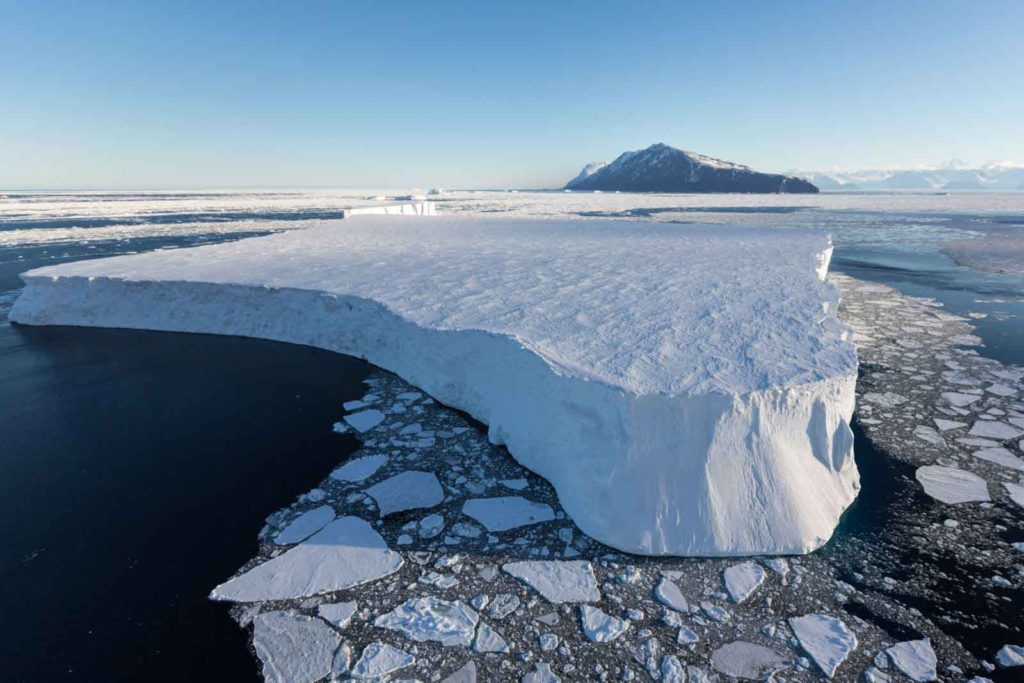
The next goal is to enter the Ross Sea from the east, venturing south toward the Bay of Whales and close to Roosevelt Island (named in 1934 by the American aviator Richard E. Byrd for President Franklin D. Roosevelt). The Bay of Whales is part of the Ross Ice Shelf, the largest ice shelf in the world, and is constantly changing with the receding ice masses. Large icebergs are present here, along with great wildlife opportunities. Roald Amundsen gained access to the shelf en route to the South Pole, which he reached on December 14, 1911. Also, the Japanese explore Nobu Shirase had his camp in this area in 1912, at Kainan Bay. You may make a helicopter landing on the ice shelf if conditions allow. During this part of the voyage, we will also cross the International Date Line.
Day 19 – 25: Sights of the Amundsen Sea
You then sail through the Amundsen Sea, moving along and through the outer fringes of the pack ice. Ice conditions are never the same from year to year, though we aim to take advantage of the opportunities that arise if sea ice is present. Emperor penguins, groups of seals lounging on the ice floes, orca and minke whales along the ice edge, and different species of fulmarine petrels are possible sights in this area.
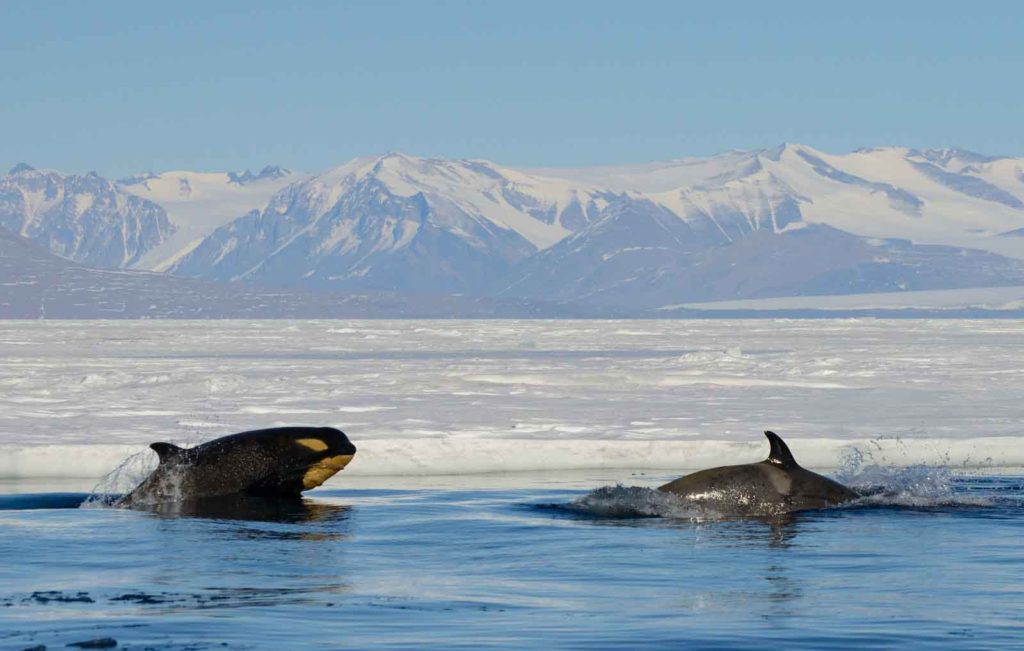
Known as Peter I Øy in Norwegian, this is an uninhabited volcanic island in the Bellingshausen Sea. It was discovered by Fabian von Bellingshausen in 1821 and named after Peter the Great of Russia. The island is claimed by Norway and considered its own territory, though it is rarely visited by passenger vessels due to its exposed nature. If weather and ice conditions allow, you may enjoy a helicopter landing on the glaciated northern part of the island. This is a unique chance to land on one of the most remote islands in the world.
Day 27 – 28: Braving the Bellingshausen
You now sail across Bellingshausen Sea, bound for the Antarctic Peninsula.
Day 29: Through the Pendleton Strait
You arrive at the Antarctic Peninsula near the Antarctic Circle in the afternoon. If sea ice allows it, you can then continue through Pendleton Strait and attempt a landing at the rarely visited southern tip of Renaud Island. Here you have the opportunity to see the first Adélie penguins of the trip as well as enjoy spectacular views of the icebergs in this surreal, snow-swept environment.
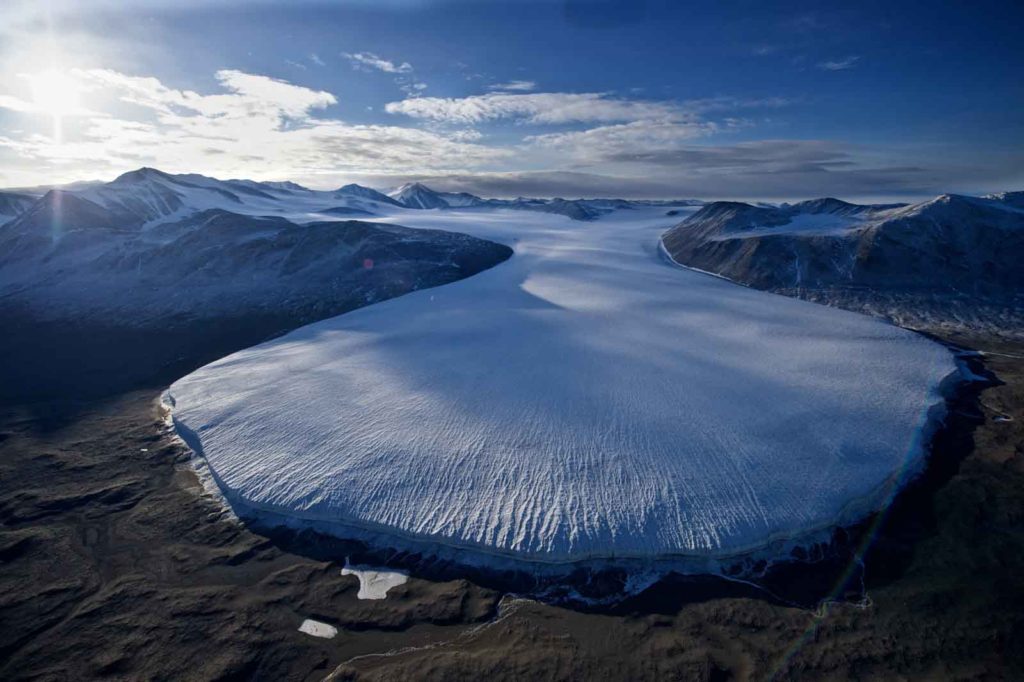
Over the following days on the Drake Passage, you enjoy some of the same experiences encountered by the great polar explorers who first charted these regions: cool salt breezes, rolling seas, maybe even a fin whale spouting up sea spray. After passing the Antarctic Convergence – Antarctica’s natural boundary, formed when north-flowing cold waters collide with warmer sub-Antarctic seas – you are in the circum-Antarctic upwelling zone. Wandering albatrosses, grey-headed albatrosses, black-browed albatrosses, light-mantled sooty albatrosses, cape pigeons, southern fulmars, Wilson’s storm petrels, blue petrels, and Antarctic petrels are a few of the birds you might see.
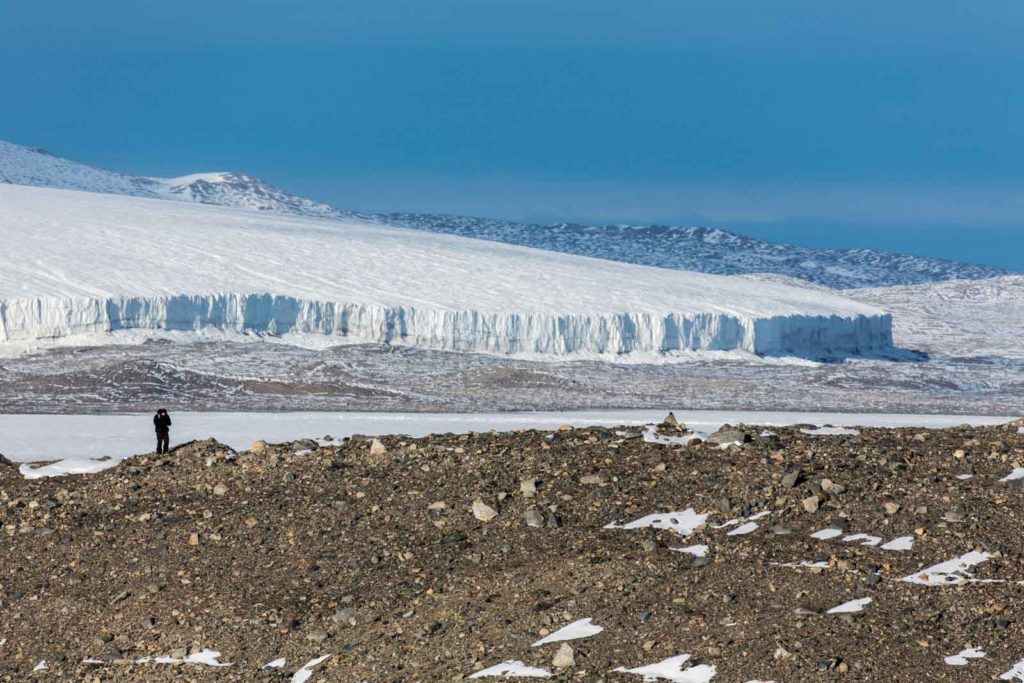
Every adventure, no matter how grand, must eventually come to an end. It’s now time to disembark in Ushuaia, reputed to be the southernmost town in the world, and return home with memories that will accompany you wherever your next adventure lies.

Included in this voyage
Excluded from this voyage
PLEASE NOTE: All itineraries are for guidance only. Programs may vary depending on local ice, weather, and wildlife conditions. The on-board expedition leader will determine the final itinerary. Flexibility is paramount for expedition cruises. The average cruising speed of m/v Ortelius is 10.5 knots. During these voyages, we transfer our passengers to shore using Zodiacs. We also operate our two helicopters in sites where Zodiacs cannot be used. Potential areas for helicopter transfer are Cape Evans (the location of Scott’s hut), Cape Royds (the location of Shackleton’s hut), the Ross Ice Shelf, Peter I Island, and the Dry Valleys. Our plan is to make five helicopter-based landings, though a specific amount of helicopter time cannot be guaranteed in advance. Helicopters provide us a great advantage in reaching certain landing sites that are otherwise almost inaccessible, but this is a true expedition in the world’s most remote area: weather, ice, and other forces of nature dictate the final itinerary. Conditions may change rapidly, impacting helicopter operations. Please understand and accept this. Safety is our greatest concern, and no compromises can be made. The vessel is equipped with two helicopters. If one helicopter is unable to fly for whatever reason, helicopter operations will cease or be cancelled. One helicopter always needs to be supported by a second functioning helicopter. No guarantees can be given, and in no event will claims be accepted. Special note: Crossing the International Date Line Depending on which direction one travels across the International Date Line, a day is either lost or gained. (Crossing westward, a day is gained; crossing eastward, a day is lost.) Please take note of this when calculating your actual time travelled. The days listed in the itinerary duration reflect the actual time travelled.
Why We Love This Trip
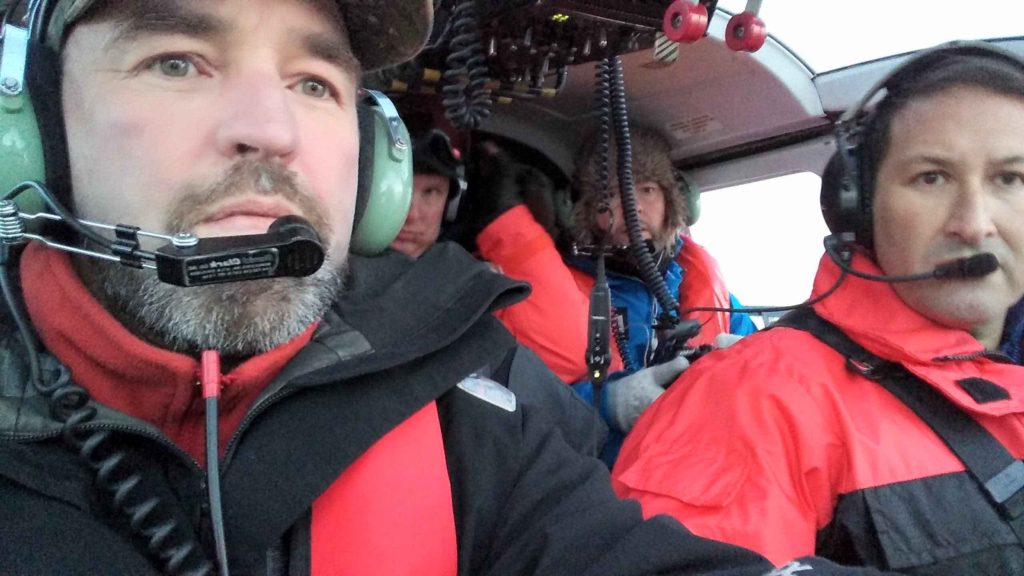
I want you to come with me on this thrilling icebreaker voyage from New Zealand to Argentina or vice versa, sailing through the Ross Sea past the incredible Antarctica full of stunning landscapes and otherworldly wildlife.
I first came to Antarctica as a tourist not expecting to ever return again, and 20 years later I still haven’t been able to leave this wonderland behind.
I’m captain Darrel Day from Queensland, Australia and I’ve spent the last 20 years leading expeditions of all kinds through Antarctica on my sailing yacht The Spirit of Sydney. But as we grew into a bigger company, we took on other fun projects like this one, which is one of my favorite ones.
This epic expedition will last 33 days and believe me I’m as excited as any one of you. I do them every season and can’t wait to go back! I’ve spent 20 years sailing through Antarctica, mountaineering, kayaking, tracking whales and helping film crews from HBO vice get the footage they need, but this adventure is unlike anything I’ve ever done before. And I want you to come with me and experience everything these unexplored regions have to offer. From penguins, to icebergs, to icebergs covered in penguins. It’s unlike any other trip on across the world, and it’s guaranteed to thrill the adventurer in you.
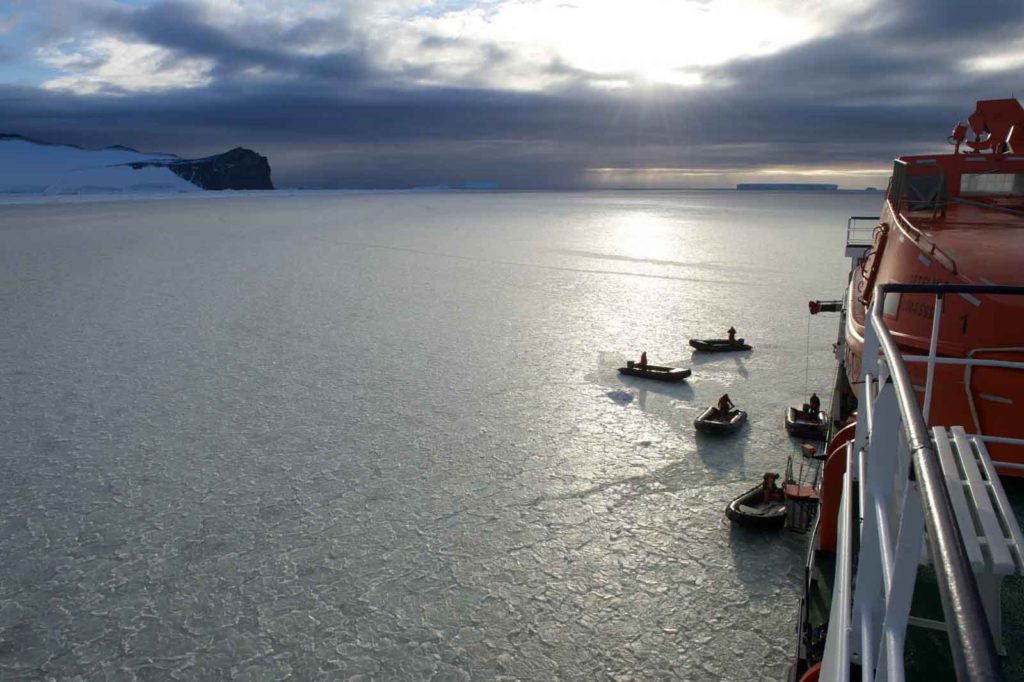
Our ship the M/V Ortelius is state of the art and comes with three helicopters which enable us to reach places that no one else can. Like the Campbell Island and the McMurdo dry valleys, only accessible with helicopters. We are the only people who offer this! The choppers will provide us with a way to access many of the ambitious landings we are hoping to execute throughout this trip, bringing you to beautiful viewpoints of the ridiculous landscapes that fill Antarctica, letting you stand and explore places entirely untouched by tourism.
During our stunning 33 days at sea we will traverse the Antarctic Peninsula continuing south through the rarely visited Bellingshausen, Amundsen Sea and the Ross Sea. We will sail past countless stunning glowing blue icebergs, incredible Antarctic mountains, massive volcanic rock formations, and wildlife unknown to all but a few brave explorers. This is the trip that gets you deeper than any other into Antarctica and even provides the potential of encountering the world famous but rarely seen Emperor Penguin and the even rarer Ross Seal (In the last season we saw around 30!!! and countless emperor penguins).
Our ship, the M/V Ortelius, is beyond trustworthy, it is downright comfortable with several different cabin options, two helicopters on board and countless other features. The vessel was originally constructed in Poland and carries the highest ice-class notation which will help to ensure your safety on this incredible journey. Our ship has a capacity of 116 adventures across 53 cabins and will allow us to reach some of the most remote waters in the entire world while maintaining a high level of comfort. I’m beyond excited to call this ship my home for this southern seas sailing season. If you want to read more about the ship just let us know and we will provide more pictures and information.
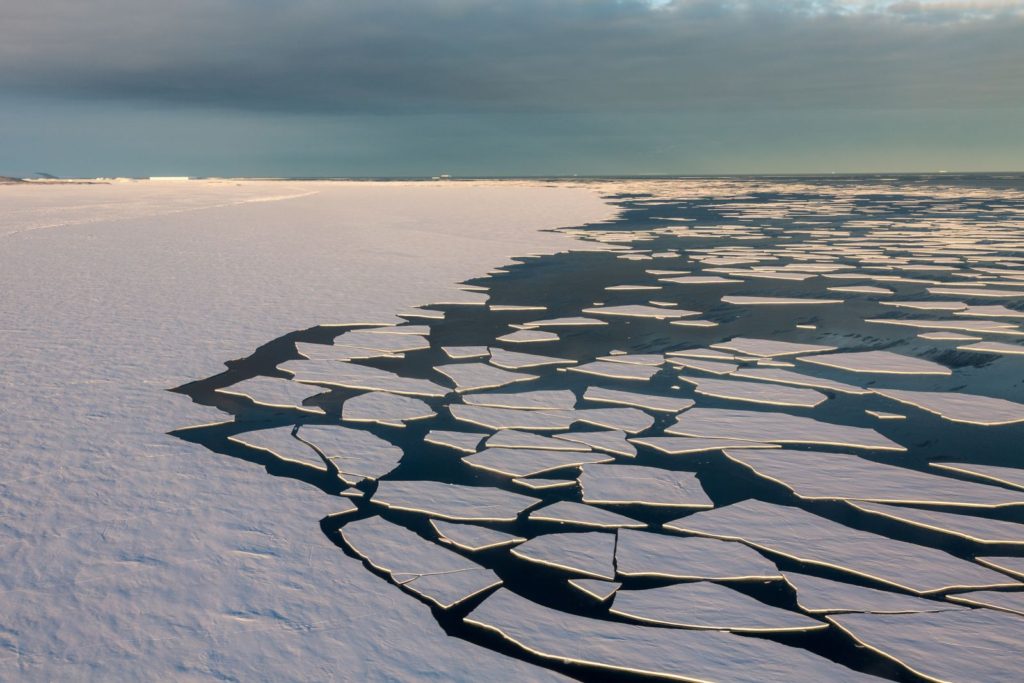
We will essentially cross the world heading from New Zealand to the charming town of Ushuaia nestled deep in Argentinean Patagonia, one of the most picturesque and stunning regions in the world. Adding a few weeks to explore the southern reaches of the Andes Mountains might well be the perfect cherry on top of this incredible trip.
Now obviously with a trip like this flexibility is key. Antarctica is remote and while we do our best to make every landing and fully experience this wondrous continent everything depends on the conditions, because keeping you safe is the number one priority. That said we will be completing every landing we can and since we are completing this voyage in the heart of Antarctic summer we anticipate a high level of success.
So If you are in search of the highest level of adventure and beauty to be found on this planet… then come sail away with me, through icebergs, whales, penguins and everything else you can imagine. I can guarantee it will be the perfect escape, the perfect adventure, and a once in a lifetime experience for anyone brave enough to come aboard with me. So, see you on board The M/V Ortelius to share this truly ludicrous trip, which is guaranteed to be the perfect escape and indeed the voyage of a lifetime.
